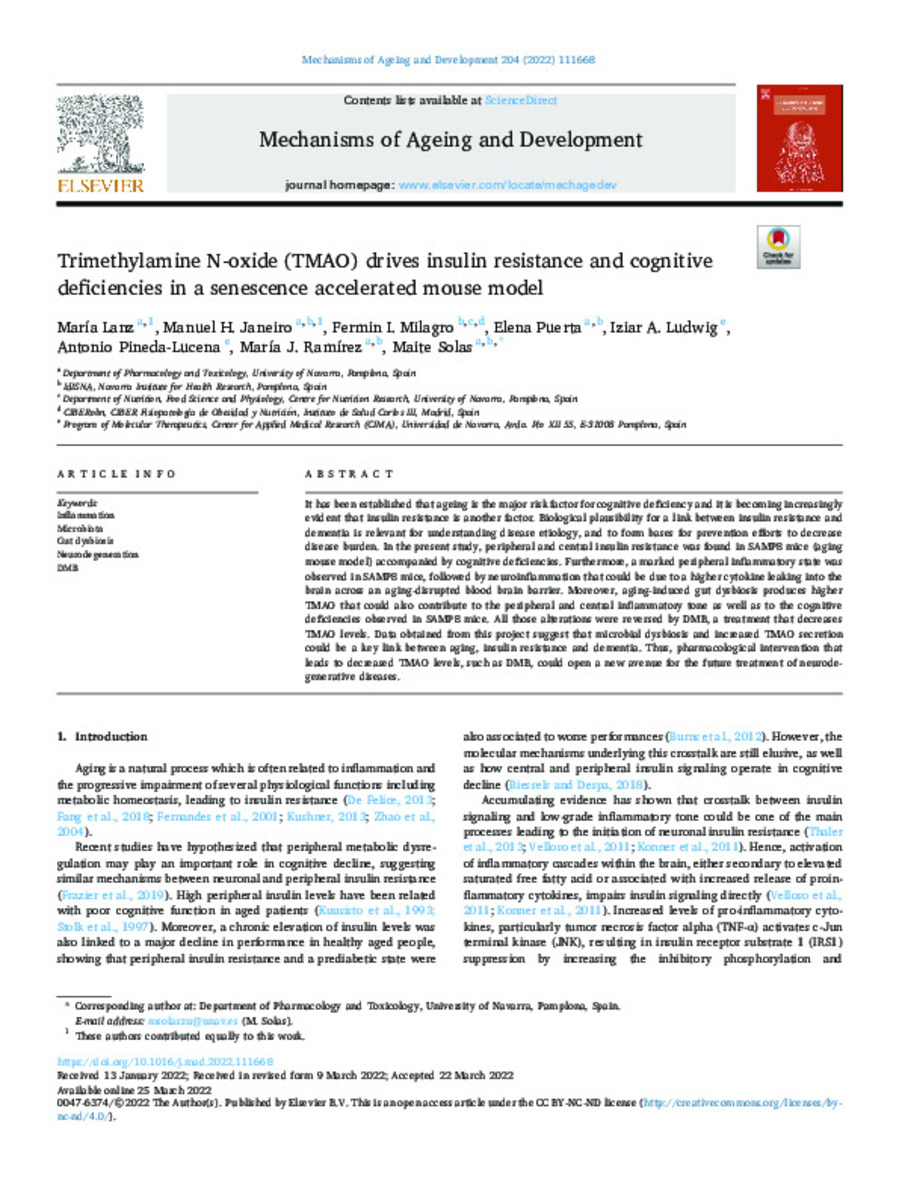Full metadata record
| DC Field | Value | Language |
|---|---|---|
| dc.creator | Lanz, M. (María) | - |
| dc.creator | Janeiro-Arenas, M.H. (Manuel Humberto) | - |
| dc.creator | Milagro-Yoldi, F.I. (Fermín Ignacio) | - |
| dc.creator | Puerta, E. (Elena) | - |
| dc.creator | Ludwig, I.A. (Iziar Amaia) | - |
| dc.creator | Pineda-Lucena, A. (Antonio) | - |
| dc.creator | Ramirez, M.J. (María Javier) | - |
| dc.creator | Solas, M. (Maite) | - |
| dc.date.accessioned | 2022-06-30T11:11:37Z | - |
| dc.date.available | 2022-06-30T11:11:37Z | - |
| dc.date.issued | 2022 | - |
| dc.identifier.citation | Lanz, M. (María); Janeiro-Arenas, M.H. (Manuel Humberto); Milagro, F.I. (Fermín I.); et al. "Trimethylamine N-oxide (TMAO) drives insulin resistance and cognitive deficiencies in a senescence accelerated mouse model". Mechanisms of Ageing and Development. (204), 2022, 111668 | es_ES |
| dc.identifier.issn | 0047-6374 | - |
| dc.identifier.uri | https://hdl.handle.net/10171/63745 | - |
| dc.description.abstract | It has been established that ageing is the major risk factor for cognitive deficiency and it is becoming increasingly evident that insulin resistance is another factor. Biological plausibility for a link between insulin resistance and dementia is relevant for understanding disease etiology, and to form bases for prevention efforts to decrease disease burden. In the present study, peripheral and central insulin resistance was found in SAMP8 mice (aging mouse model) accompanied by cognitive deficiencies. Furthermore, a marked peripheral inflammatory state was observed in SAMP8 mice, followed by neuroinflammation that could be due to a higher cytokine leaking into the brain across an aging-disrupted blood brain barrier. Moreover, aging-induced gut dysbiosis produces higher TMAO that could also contribute to the peripheral and central inflammatory tone as well as to the cognitive deficiencies observed in SAMP8 mice. All those alterations were reversed by DMB, a treatment that decreases TMAO levels. Data obtained from this project suggest that microbial dysbiosis and increased TMAO secretion could be a key link between aging, insulin resistance and dementia. Thus, pharmacological intervention that leads to decreased TMAO levels, such as DMB, could open a new avenue for the future treatment of neurodegenerative diseases. | es_ES |
| dc.language.iso | eng | es_ES |
| dc.publisher | Elsevier | es_ES |
| dc.rights | info:eu-repo/semantics/openAccess | es_ES |
| dc.subject | Inflammation | es_ES |
| dc.subject | Microbiota | es_ES |
| dc.subject | Gut dysbiosis | es_ES |
| dc.subject | Neurodegeneration | es_ES |
| dc.subject | DMB | es_ES |
| dc.title | Trimethylamine N-oxide (TMAO) drives insulin resistance and cognitive deficiencies in a senescence accelerated mouse model | es_ES |
| dc.type | info:eu-repo/semantics/article | es_ES |
| dc.description.note | This is an open access article under the CC BY-NC-ND license | es_ES |
| dc.identifier.doi | 10.1016/j.mad.2022.111668 | - |
| dadun.citation.number | 204 | es_ES |
| dadun.citation.publicationName | Mechanisms of Ageing and Development | es_ES |
| dadun.citation.startingPage | 111668 | es_ES |
Files in This Item:
Statistics and impact
Items in Dadun are protected by copyright, with all rights reserved, unless otherwise indicated.






